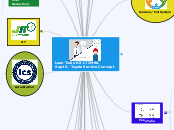by Felipe Quintana 8 years ago
1838
Lean Tools Kit LT IMBA Sep16

by Felipe Quintana 8 years ago
1838

More like this
Haidilao is a hotpot restaurant in china that applies an interesting solution to long waits for tables. They provide free manicures, boardgames, videogames, phone charging stations and comfortable loungechairs.
Value stream mapping is a lean manufacturing or lean enterprise technique used to document, analyze and improve the flow of information or materials required to produce a product or service for a customer. Full definition.
———-
Value stream mapping is a paper and pencil tool that helps you to see and understand the flow of material and information as a product or service makes its way through the value stream. Value stream mapping is typically used in Lean, it differs from the process mapping of Six Sigma in four ways:
1) It gathers and displays a far broader range of information than a typical process map.
2) It tends to be at a higher level (5-10 boxes) than many process maps.
3) It tends to be used at a broader level, i.e. from receiving of raw material to delivery of finished goods.
Identify which part of the manufacturing process limits the overall throughput and improve the performance of that part of the process.
Improves throughput by strengthening the weakest link in the manufacturing process.
Manufacturing where work-in-process smoothly flows through production with minimal (or no) buffers between steps of the manufacturing process.
Eliminates many forms of waste (e.g. inventory, waiting time, and transport).
Pull parts through production based on customer demand instead of pushing parts through production based on projected demand. Relies on many lean tools, such asContinuous Flow, Heijunka, Kanban, Standardized Work and Takt Time
Highly effective in reducing inventory levels. Improves cash flow and reduces space requirements.
Reduce setup (changeover) time to less than 10 minutes. Techniques include:
A form of production scheduling that purposely manufactures in much smaller batches by sequencing (mixing) product variants within the same process.
Reduces lead times (since each product or variant is manufactured more frequently) and inventory (since batches are smaller).
A holistic approach to maintenance that focuses on proactive and preventative maintenance to maximize the operational time of equipment. TPM blurs the distinction between maintenance and production by placing a strong emphasis on empowering operators to help maintain their equipment.
Creates a shared responsibility for equipment that encourages greater involvement by plant floor workers. In the right environment this can be very effective in improving productivity (increasing up time, reducing cycle times, and eliminating defects).
Anything in the manufacturing process that does not add value from the customer’s perspective.
It doesn’t. Muda means ‘waste’. The elimination of muda (waste) is the primary focus of lean manufacturing.
Mauricio Gamboa
Derek Thomas
Philipp Würssch
Eduardo Soares
An iterative methodology for implementing improvements:
Applies a scientific approach to making improvements:
Design error detection and prevention into production processes with the goal of achieving zero defects.
It is difficult (and expensive) to find all defects through inspection, and correcting defects typically gets significantly more expensive at each stage of production.
A method of regulating the flow of goods both within the factory and with outside suppliers and customers. Based on automatic replenishment through signal cards that indicate when more goods are needed.
Eliminates waste from inventory and overproduction. Can eliminate the need for physical inventories (instead relying on signal cards to indicate when more goods need to be ordered).
A strategy where employees work together proactively to achieve regular, incremental improvements in the manufacturing process.
Combines the collective talents of a company to create an engine for continually eliminating waste from manufacturing processes.
Kaizen Toyota
Design equipment to partially automate the manufacturing process (partial automation is typically much less expensive than full automation) and to automatically stop when defects are detected.
After Jidoka, workers can frequently monitor multiple stations (reducing labor costs) and many quality issues can be detected immediately (improving quality).
Organize the work area:
Eliminates waste that results from a poorly organized work area (e.g. wasting time looking for a tool).